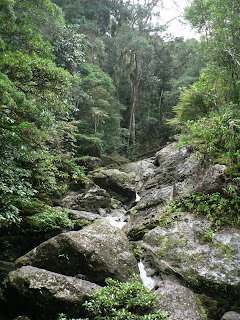The Masoala Peninsula

 The Masoala Peninsula in north eastern Madagascar is considered a bio-diversity hotspot, as more than 80% of the plants and animals there are found no where else on earth. Most of the peninsula is a protected forest, and it remains largely because it is a bit hard to get to. However, you can fly to Maroansetra and then take a boat over to the peninsula, or a boat from nearby Nosy Mangabe. On the way you will pass two small round islands which are uninhabited by people. They are home to the world's largest bats, the Madagascar flying foxes. These very large (wing span 5') bats can be seen sometimes hanging from the trees. The day I passed by, I saw a tree full of them hanging upside down, as well as a swirling circle of them above the tree. As it was mid-day, it was unusual for them to be awake, and I don't know why they were. I am glad I got the chance to see them.
The Masoala Peninsula in north eastern Madagascar is considered a bio-diversity hotspot, as more than 80% of the plants and animals there are found no where else on earth. Most of the peninsula is a protected forest, and it remains largely because it is a bit hard to get to. However, you can fly to Maroansetra and then take a boat over to the peninsula, or a boat from nearby Nosy Mangabe. On the way you will pass two small round islands which are uninhabited by people. They are home to the world's largest bats, the Madagascar flying foxes. These very large (wing span 5') bats can be seen sometimes hanging from the trees. The day I passed by, I saw a tree full of them hanging upside down, as well as a swirling circle of them above the tree. As it was mid-day, it was unusual for them to be awake, and I don't know why they were. I am glad I got the chance to see them.We also saw dolphins and tuna on the way to the peninsula, and certain times of the year you can see humpback whales there too. I stayed at a lovely place called Masola Forest Camp. The couple who own it have taken great care to be environmentally responsible, yet create a relatively luxurious haven in Madagascar for travelers. They have safari-style large canvas tents pemanently erected on wood platforms. Each has its own hammock and plenty of windows for ventilation. There is a small separate shack containing a shower for each tent, and yet another small shack housing a flush toilet and sink. While there is no hot water, it is warm enough that you won't miss it - and if you do they will heat some for you. The staff is excellent and laundry is included, always a plus on long journeys. In addition, they have several dogs who are well treated and are family pets, and some feral cats who are doing alright on leftovers. (It was nice to see animals valued and treated well in this country where they are usually treated so horribly). The food is good, and I highly recommend this as a place to stay.
The forest here is home to red-ruffed lemurs (pictured here) as well as white-ruffed brown lemurs. The forest is so large that the animals are not habituated and you will not get as close to them as other places. One drawback is that to access the trails in the forest you have to hike about 2km along the beach. This is hard work as the beach sand is tough to walk in, and there is no shade...and you have to do the same 2k on the way back, in addition to your upward hike in the forest.
There is an awesome waterfall you can hike to if you are willing to make a number of river crossings on foot. It is tricky as there are places with no trails and vegetation so high and thick you can't see anything around you, but it's worth it. I enjoyed the hike very much, even though the only mammal we saw was a brown lemur from quite a distance. The unusual plants, frogs and bugs were interesting, and just the experience of hiking in the rainforest is great. I am shocked how photos COMPLETELY fail to portray things...but here is a photo of part of the waterfall. In person it is way more impressive, as there are enormously tall trees on top and about 4 layers of waterfalls and huge rocks below. The water is cool and clear. The surrounding forest is lush and green. Truly a place worth seeing.

Comments